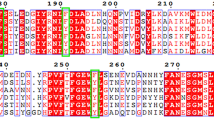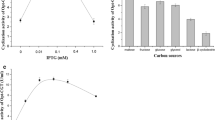Abstract
In this study, site saturation mutagenesis was performed on the − 3 (R44, D86, S90, and D192) and − 6 subsite (Y163, G175, G176, and N189) of Bacillus stearothermophilus NO2 cyclodextrin glucosyltransferase to enhance its specificity for the donor substrate maltodextrin for 2-O-α-D-glucopyranosyl-L-ascorbic acid (AA-2G) preparation. The AA-2G yields produced by the mutants S90D, G176H, and S90D/G176H were 181, 171, and 185 g/L, respectively. Our previous study found that the mutant K228R/M230L also increased the AA-2G yield. Therefore, the mutants S90D, G176H, S90D/G176H, and K228R/M230L were further used to generate combinatorial mutants. Among these mutants, the highest AA-2G yield (217 g/L) was produced by S90D/K228R/M230L with 500 g/L maltodextrin as the glucosyl donor, which was 56 g/L higher than that produced by wild-type CGTase. In addition, AA-2G was prepared by adding isoamylase to hydrolyze α-1,6 glucosidic linkages in maltodextrin that could not be utilized by CGTase to improve the utilization rate of maltodextrin. The addition of isoamylase reduced the concentration of maltodextrin from 500 to 350 g/L, while the AA-2G yield remained high (208 g/L). The preparation of AA-2G by complexing isoamylase with mutant S90D/K228R/M230L reduced the maltodextrin concentration by 150 g/L, while the AA-2G yield increased by 47 g/L than preparation with wild-type CGTase alone, which laid a foundation for the large-scale preparation of AA-2G.
Key points
• Mutants exhibited improved maltodextrin specificity.
• Mutant S90D/K228R/M230L produced high yield of AA-2G with maltodextrin as substrate.
• AA-2G was first synthesized by a combination of isoamylase and CGTase.





Similar content being viewed by others
Data availability
The authors declare that all data supporting the findings of this study are available within this article.
References
Aga H, Yoneyama M, Sakai S, Yamamoto I (1991) Synthesis of 2-O-α-D-glucopyranosyl L-ascorbic acid by cyclomaltodextrin glucanotransferase from Bacillus stearothermophilus. Agric Biol Chem 55(7):1751–1756. https://doi.org/10.1080/00021369.1991.10870856
Agarwal A, Hager DN, Sevransky JE (2021) Any role of high-dose vitamin C for septic shock in 2021? Semin Resp Crit Care 42(05):672–682. https://doi.org/10.1055/s-0041-1733986
Borner T, Roger K, Adlercreutz P (2014) Hydrophobic complexation promotes enzymatic surfactant synthesis from alkyl glucoside/cyclodextrin mixtures. ACS Catal 4(8):2623–2634. https://doi.org/10.1021/cs500192q
Duan X, Wu J (2013) Advances in studying microbial GH13 starch debranching enzyme-a review. Acta Microbiol Sin 53(7):648–656
Grell L, Parkin C, Slatest L, Craig PA (2006) Viz, a tool for simplifying molecular viewing in PyMOL. Biochem Mol Biol Edu 34(6):402–407. https://doi.org/10.1002/bmb.2006.494034062672
Han R, Liu L, Li J, Du G, Chen J (2012) Functions, applications and production of 2-O-D-glucopyranosyl-L-ascorbic acid. Appl Microbiol Biot 95(2):313–320
Han R, Liu L, Shin H-d, Chen RR, Li J, Du G, Chen J (2013a) Iterative saturation mutagenesis of-6 subsite residues in cyclodextrin glycosyltransferase from Paenibacillus macerans to improve maltodextrin specificity for 2-O-D-glucopyranosyl-L-ascorbic acid synthesis. Appl Environ MicrobI 79(24):7562–7568. https://doi.org/10.1128/aem.02918-13
Han R, Liu L, Shin H-d, Chen RR, Li J, Du G, Chen J (2013b) Systems engineering of tyrosine 195, tyrosine 260, and glutamine 265 in cyclodextrin glycosyltransferase from Paenibacillus macerans to enhance maltodextrin specificity for 2-O-D-glucopyranosyl-L-ascorbic acid synthesis. Appl Environ MicrobI 79(2):672–677. https://doi.org/10.1128/aem.02883-12
Hii SL, Tan JS, Ling TC, Ariff AB (2012) Pullulanase: role in starch hydrolysis and potential industrial applications. Enzyme Res 2012:921362
Kelley LA, Mezulis S, Yates CM, Wass MN, Sternberg MJE (2015) The Phyre2 web portal for protein modeling, prediction and analysis. Nat Protoc 10(6):845–858. https://doi.org/10.1038/nprot.2015.053
Kelly RM, Dijkhuizen L, Leemhuis H (2009) The evolution of cyclodextrin glucanotransferase product specificity. Appl Microbiol Biot 84(1):119–133. https://doi.org/10.1007/s00253-009-1988-6
Liu L, Xu Q, Han R, Shin H-d, Chen RR, Li J, Du G, Chen J (2013) Improving maltodextrin specificity for enzymatic synthesis of 2-O-D-glucopyranosyl-L-ascorbic acid by site-saturation engineering of subsite-3 in cyclodextrin glycosyltransferase from Paenibacillus macerans. J Biotechnol 166(4):198–205. https://doi.org/10.1016/j.jbiotec.2013.05.005
Muccino RR, Markezich R, Vernice GG, Perry CW, Liebman AA (1976) The preparation of L-ascorbic acid 2-sulfate-35S having a high specific activity. Carbohyd Res 47(1):172–175. https://doi.org/10.1016/s0008-6215(00)83562-4
Naidu KA (2003) Vitamin C in human health and disease is still a mystery ? An overview. Nutr J 2:7–7. https://doi.org/10.1186/1475-2891-2-7
Rendleman JA (1997) Enhancement of cyclodextrin production through use of debranching enzymes. Biotechnol Appl Bioc 26:51–61
Song W, Zheng K, Xu X, Gao C, Guo L, Liu J, Chen XL, Liu LM, Hu GP, Wu J (2021a) Enzymatic production of ascorbic acid-2-phosphate by engineered Pseudomonas aeruginosa acid phosphatase. J Agr Food Chem 69(47):14215–14221. https://doi.org/10.1021/acs.jafc.1c04685
Song K, Sun J, Wang W, Hao J (2021b) Heterologous expression of cyclodextrin glycosyltransferase my20 in Escherichia coli and its application in 2-O-alpha-d-glucopyranosyl-L-ascorbic acid production. Front Microbiol 12:1–11. https://doi.org/10.3389/fmicb.2021.664339
Tao X, Wang T, Su L, Wu J (2018) Enhanced 2-O-alpha-D-glucopyranosyl-L-ascorbic acid synthesis through iterative saturation mutagenesis of acceptor subsite residues in Bacillus stearothermophilus NO2 cyclodextrin glycosyltransferase. J Agr Food Chem 66(34):9052–9060. https://doi.org/10.1021/acs.jafc.8b03080
Tao X, Su L, Wu J (2019) Current studies on the enzymatic preparation 2-O-alpha-D-glucopyranosyl-L-ascorbic acid with cyclodextrin glycosyltransferase. Crit Rev Biotechnol 39(2):249–257. https://doi.org/10.1080/07388551.2018.1531823
Tao X, Su L, Wang L, Chen X, Wu J (2020) Improved production of cyclodextrin glycosyltransferase from Bacillus stearothermophilus NO2 in Escherichia coli via directed evolution. Appl Microbiol Biot 104(1):173–185. https://doi.org/10.1007/s00253-019-10249-8
Uitdehaag JCM, Mosi R, Kalk KH, van der Veen BA, Dijkhuizen L, Withers SG, Dijkstra BW (1999) X-ray structures along the reaction pathway of cyclodextrin glycosyltransferase elucidate catalysis in the alpha-amylase family. Nat Struct Biol 6(5):432–436. https://doi.org/10.1038/8235
van der Veen BA, van Alebeek G, Uitdehaag JCM, Dijkstra BW, Dijkhuizen L (2000) The three transglycosylation reactions catalyzed by cyclodextrin glycosyltransferase from Bacillus circulans (strain 251) proceed via different kinetic mechanisms. Eur J Biochem 267(3):658–665. https://doi.org/10.1046/j.1432-1327.2000.01031.x
Xi CS (2001) Determination of VC with phosphomolybdate-blue spectrophotometry. Spectrosc Spect Anal 21(5):723–725
Xia W, Zhang K, Su LQ, Wu J (2021) Microbial starch debranching enzymes: developments and applications. Biotechnol Adv 50:107786. https://doi.org/10.1016/j.biotechadv.2021.107786
Xiao Y-H, Pei Y (2011) Asymmetric overlap extension PCR method for site-directed mutagenesis. Methods Mol Biol 687:277–282. https://doi.org/10.1007/978-1-60761-944-4_20
Xiong Y (2015) The study of 2-O-α-d-glucopyranosyl-l-ascorbic acid synthesis by cyclodextrin glycosyltransferase. Dissertation, Jiangnan University.
Xu Q, Han R, Li J, Du G, Liu L, Chen J (2014) Improving maltodextrin specificity by site-saturation engineering of subsite +1 in cyclodextrin glycosyltransferase from Paenibacillus macerans. Chin J Biotechnol 30(1):98–108
Zhang W, Huang Q, Yang R, Zhao W, Hua X (2021) 2-O-D-glucopyranosyl-L-ascorbic acid: properties, production, and potential application as a substitute for L-ascorbic acid. J Func Foods 82:104481. https://doi.org/10.1016/j.jff.2021.104481
Funding
This study was financially supported by the National Natural Science Foundation of China (31730067, 32001637, 31972032, and 31771916), the Natural Science Foundation of Jiangsu Province (BK20221536), and the Agricultural Independent Innovation Fund of Jiangsu Province (CX (21)3039).
National Natural Science Foundation of China,31730067,Jing Wu,32001637,Lei Wang,31972032,Sheng Chen,31771916,Lingqia Su,Natural Science Foundation of Jiangsu Province,BK20221536,Lei Wang,Agricultural independent innovation fund of Jiangsu Province (CX (21)3039)
Author information
Authors and Affiliations
Contributions
XMT conducted the experiments and writing—original draft. LQS and SC data curation, methodology, writing—review and editing, and validation. LW and JW conceived and designed the research. All authors revised and approved the final manuscript.
Corresponding authors
Ethics declarations
Ethical statement
This article does not contain any studies with human participants or animals performed by any of the authors.
Conflict of interest
The authors declare no competing interests.
Additional information
Publisher's Note
Springer Nature remains neutral with regard to jurisdictional claims in published maps and institutional affiliations.
Supplementary Information
Below is the link to the electronic supplementary material.
Rights and permissions
Springer Nature or its licensor (e.g. a society or other partner) holds exclusive rights to this article under a publishing agreement with the author(s) or other rightsholder(s); author self-archiving of the accepted manuscript version of this article is solely governed by the terms of such publishing agreement and applicable law.
About this article
Cite this article
Tao, X., Su, L., Chen, S. et al. Producing 2-O-α-D-glucopyranosyl-L-ascorbic acid by modified cyclodextrin glucosyltransferase and isoamylase. Appl Microbiol Biotechnol 107, 1233–1241 (2023). https://doi.org/10.1007/s00253-023-12367-w
Received:
Revised:
Accepted:
Published:
Issue Date:
DOI: https://doi.org/10.1007/s00253-023-12367-w




